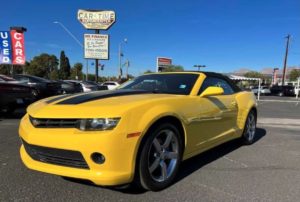Unless you’re a car enthusiast, you probably don’t think about the differences between classic and vintage cars. But for car lovers, the difference has been hotly debated for decades. Don’t even get them started on the differences between vintage and antique cars! Still, it’s not only car clubs that have a say. Insurance companies and individual states also define car classes—just not the same! While the classic vs. vintage vs. antique cars discussion may not have a clear ending, we can give you some clarity.
The Differences Between Classic, Vintage, and Antique Cars (Give or Take!)
Finding a consensus for defining vintage, classic, and antique cars is difficult. There’s a lot of overlap between each group, but there are widely accepted criteria for each classification to help us cover all the bases. Here’s the breakdown:
Classic Cars
To many of us, especially avid car lovers, the term “classic” means more than old or out of production. A classic car symbolizes popular, bygone eras that featured unique engineering, design, or historical importance. Classic cars are highly collectible and enjoy a thriving market of enthusiastic buyers. You can see these iconic cars in exhibitions, museums, and car shows across the country. Here are some of the most popular classic cars you’ll find:
- 1963 Mercedes-Benz 300SL Gullwing
- 1970 Chevrolet Chevelle SS
- 1972 Ford Mustang Mach 1
- 1978 Chevrolet Camaro Z28
- 1979 Ford Bronco
- 1979 Pontiac Firebird Trans Am
- 1986 Chevrolet Monte Carlo SS
- 1987 Buick Grand National GNX
Antique Cars
The most commonly accepted criteria for an antique classification is that a car must be over 44 years old. Antique cars don’t see many road trips, but they make for exciting restorations. There is a thriving antique car show circuit, so if you get a chance to catch one, we guarantee you’ll be impressed. The antique class includes many iconic models, including two original muscle cars and some pretty stylish rides. Here are three decades of antique icons:
- 1932 Ford Roadster
- 1938 Volkswagen Beetle
- 1951 Oldsmobile Super 88
- 1954 Rolls Royce Phantom
- 1956 Porsche Speedster
- 1957 Chevrolet Corvette
- 1957 Chevrolet Bel Air Convertible
- 1964 Chevy El Camino Coupe
- 1968 Dodge Charger
Vintage Cars
The difference between vintage and antique cars is evident. These cars are ancient! Most car enthusiasts consider vehicles manufactured between 1918 and 1930 to be vintage. Like the antiques, you won’t see many of them on the road—you’ll have to go to an exhibit or show to check them out. Not only are vintage cars the oldest and often most luxurious, they are typically the most expensive. Vintage cars aren’t easy to find, but here are a few you should be on the lookout for:
- 1919 Ford Model T Sedan
- 1921 Hudson Super Six Phaeton
- 1924 Aston Martin Grand Prix
- 1925 Flint Model E-55
- 1926 Duesenberg Model A
- 1929 Pierce-Arrow
- 1929 Mercedes-Benz 680s Torpedo
- 1930 Cadillac V-16
Pinning down the differences between classic, vintage, and antique cars doesn’t look promising anytime soon. While your state and insurance company have the final say, one of the most famous and passionate car collectors, Jay Leno, has this advice. If the car is of technical or historical interest, fun to drive, and beautiful—buy it if you can afford it!
Is My Ride a Vintage, Classic, or Antique Car?
The Classic Car Club of America defines a classic as a “fine or distinctive automobile built between 1915 and 1948”. The Vintage Sports Car Club of America considers pre-World War 11 cars vintage. Insurance companies put sports cars in a unique class and do the same for older cars. State Farm deems a vehicle of historical interest and 10-24 years old to be a classic and anything older to be an antique. Nationwide, however, classifies any car manufactured before 1995 as a classic. In addition to car clubs and insurers, states can’t agree either.
In North Carolina, a car is classified as a classic if it’s at least 30 years old—at which time it can be registered as an antique! If you live in California, you’ll encounter yet another take on classifications. You can register your vehicle as a historical car if it is at least25 years old, manufactured after 1922, and of historical interest. However, cars made over 34 years ago are classified as collector cars!While it’s fun to debate the differences, where the rubber meets the road, it’s state laws, insurers, and car clubs that make the call.
Car Time Supercenter—Your Classic Hometown Dealership
The debate over classic vs. vintage vs. antique cars will no doubt continue until we all agree, so don’t hold your breath! But there’s no debate over where to find Tucson’s best used cars and trucks. Car Time Supercenter is a family-owned local dealership offering a large selection, flexible financing, and hometown service. Who knows? Your next car could turn out to be a classic collectible.

There are good reasons people will buy their next used car in Tucson from Car Time Supercenter. But I think we are one of the most trusted used car dealerships mainly because we treat everyone like family. My family has provided quality, dependable local used cars to Tucson customers since 1984, and I’m proud to be a part of our continued success.
Like many family-owned businesses, I grew up going to work with my dad. Falling in love with cars was natural because of my father’s passion, and eventually, I came to love the car business just like him. I officially joined the Car Time Supercenter team in 2012, starting in the finance department. Over the past decade, I’ve learned the used car business and how to treat customers from my family and industry resources.
Today, I oversee marketing, social media, inventory, and reconditioning, so I play an essential role in delivering local Tucson used car buyers the best experience possible. I also help our family business keep up with the times while providing old-fashioned customer service. From attending NADA classes to becoming Allstate certified for back-end products, I continue to learn and add skills to serve our customers better.




